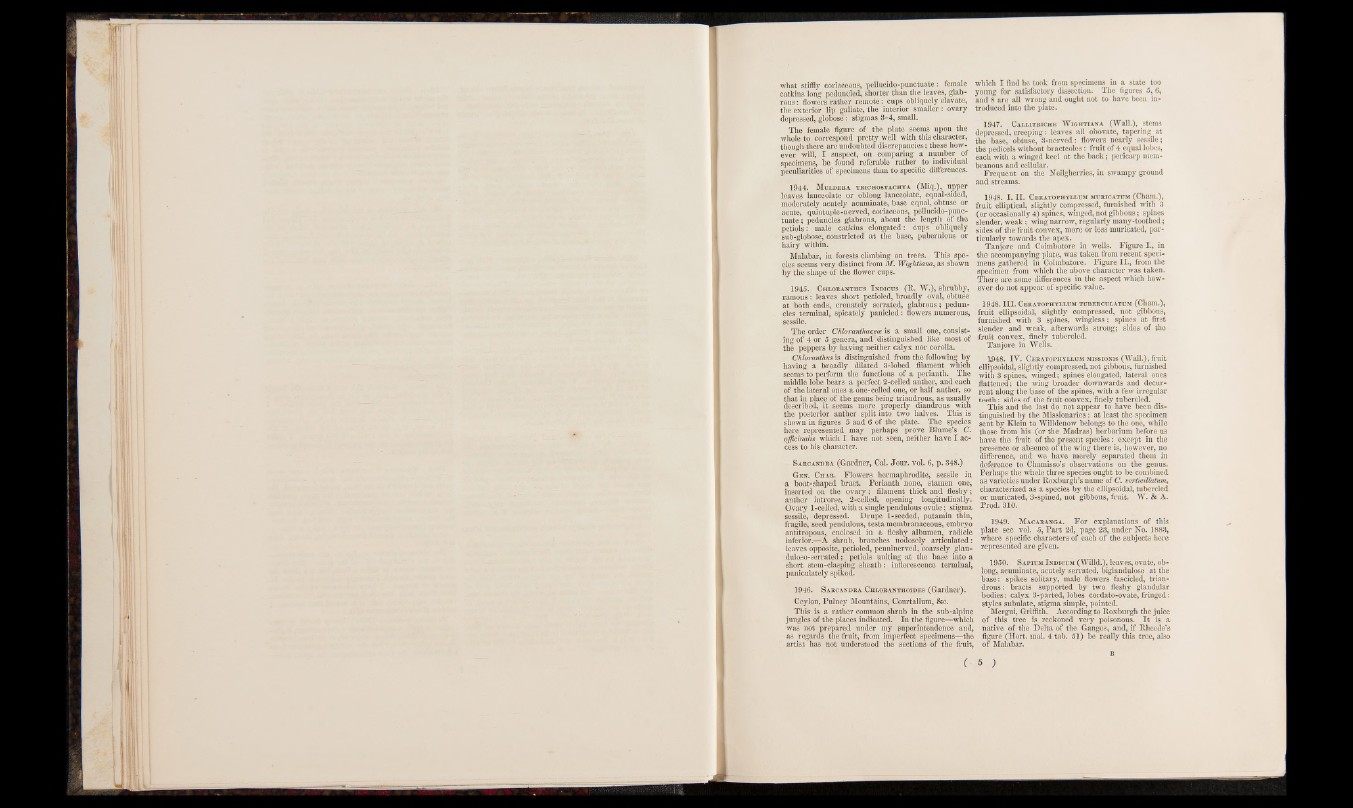
what stiffly coriaceous, pellucido-punctuate: female
catkins long peduncled, shorter than the leaves, glabrous
: flowers rather remote: cups obliquely clavate,
the exterior lip galiate, the interior smaller: ovary
depressed, globose: stigmas 3-4, small.
The female figure of the plate seems upon the
whole to correspond pretty well with this character,
though there are undoubted discrepancies; these however
will, I suspect, on comparing a number of
specimens, be found referable rather to individual
peculiarities of specimens than to specific differences.
1944. Mulder a trichostachya (Miq.), upper
leaves lanceolate or oblong lanceolate, equal-sided,
moderately acutely acuminate, base equal, obtuse or
acute, quintuple-nerved, coriaceous, pellucido-punctuate;
peduncles glabrous, about the length of the
petiqls: male catkins elongated: cups obliquely
sub-globose, constricted at the base, puberulous or
hairy within.
Malabar, in forests climbing on trees. This species
seems very distinct from M. Wightiana, as shown
by the shape of the flower cups.
1945. Cheoranthus Tndicus (R. W.)i shrubby,
ramous: leaves short petioled, broadly oval, obtuse
at both ends, crenately serrated, glabrous ; peduncles
terminal, spicately panicled: flowers numerous,
sessile.
The order CUorantkac.e<B is a small one, consisting
of 4 or 5 genera, and " distinguished like most of
the peppers by having neither calyx nor corolla.
Chloranthus is distinguished from the following by
having a broadly dilated 3-lobed filament which
seems to perform the functions of a perianth. The
middle lobe bears a perfect 2-celled anther, and each
of the lateral ones a one-celled one, or half anther, so
that in place of the genus being triandrous, as usually
described, it seems more properly diandrous with
the posterior anther split into two halves. This is
shown in figures 5 and 6 of the plate. The species
here represented may perhaps prove Blume’s C.
officinalis which I have not seen, neither have I access
which I find he took from specimens in a state too
young for satisfactory dissection. The figures 5, 6,
and 8 are all wrong and ought not to have been introduced
to his character.
Sarcandra (Gardner, Cal. Jour. vol. 6, p. 348.)
Gen. Char. Flowers hermaphrodite, sessile in
a boat-shaped bract. Perianth none, stamen one,
inserted on the o vary; filament thick and fleshy;
anther introrse, 2-celled, opening longitudinally.
Ovary 1-celled, with a single pendulous ovule; stigma
sessile, depressed. Drupe 1-seeded, putamin thin,
fragile, seed pendulous, testa membranaceous, embryo
antitropous, enclosed in a fleshy albumen, radicle
inferior.—A shrub, branches nodosely articulated:
leaves opposite, petioled, penninerved, coarsely glan-
duloso-serrated; petiols uniting at the base into a
short stem-clasping sheath: inflorescence terminal,
paniculately spiked.
1946. S arcandra Cheobanthoedes (Gardner).
Ceylon, Pulney Mountains, Courtallum, &c.
This is a rather common shrub in the sub-alpine
jungles of the places indicated. In the figure—which
was not prepared under my superintendence and,
as regards the fruit, from impei*fect specimens—the
artist has not understood the sections of the fruit,
into the plate.
1947. Caelitriche W ightiana (Wall.), stems
depressed, creeping: leaves all obovate, tapering at
the base, obtuse, 3-nerved: flowers nearly sessile;
the pedicels without bracteolcs: fruit of 4 equal lobes,
each with a winged keel at the back; pericarp membranous
and cellular.
Frequent on the Neilgherries, in swampy ground
and streams.
1948. I. I I . Ceratophyleum muricatum (Cham.),
fruit elliptical, slightly compressed, furnished with 3
(or occasionally 4) spines, winged, not gibbous; spines
slender, weak; wing narrow, regularly many-toothed;
sides of the fruit convex, more or less muricated, particularly
towards the apex.
Tanjore and Coimbatore in wells. Figure I., in
the accompanying plate, was taken from recent specimens
gathered in Coimbatore. Figure II., from the
specimen from which the above character was taken.
There are some differences in the aspect which however
do not appear of specific value.
1948. II I. Ceratophyleum tuberculatum (Cham.),
fruit ellipsoidal, slightly compressed, not gibbous,
furnished with 3 spines, wingless; spines at first
slender and weak, afterwards strong; sides of the
fruit convex, finely tubercled.
Tanjore in Wells,
1948. IV. Ceratophyleum missionis (Wall.), fruit
ellipsoidal, slightly compressed, not gibbous, furnished
with 3 spines, winged; spines elongated, lateral ones
flattened; the wing broader downwards and decurrent
along the 'base of the spines, with a few irregular
teeth: sides of the fruit convex, finely tubercled.
This and the last do not appear to have been distinguished
by the Missionaries: at least the specimen
sent by Klein to Willdenow belongs to the one, while
those from his (or the Madras) herbarium before us
have the fruit of the present species: except in the
presence or absence of the wing there is, however, no
difference, and we have merely separated them in
deference to Chamisso’s observations on the genus.
Perhaps the whole three species ought to be combined
as varieties under Roxburgh’s name of C. verticiUatum,
characterized as a species by the ellipsoidal, tubercled
or muricated, 3-spined, not gibbous, fruit. W. & A.
Prod. 310.
1949. Macaranga. For explanations of this
plate see vol. 5, Part 2d, page 23, under No. 1883,
where specific characters of each of the subjects here
represented are given.
1950. Sapium I ndicum (Willd.), leaves, ovate, oblong,
acuminate, acutely serrated, biglandulose at the
base: spikes solitary, male flowers fascicled, triandrous
: bracts supported by two fleshy glandular
bodies: calyx 3-parted, lobes cordato-ovate, fringed:
styles subulate, stigma simple, pointed.
Mergui, Griffith. According to Roxburgh the juice
of this tree is reckoned very poisonous. I t is a
native of the Delta of the Ganges, and, if Rheede’s
figure (Hort. mal. 4 tab. 51) be really this tree, also
of Malabar.
B
■ s )